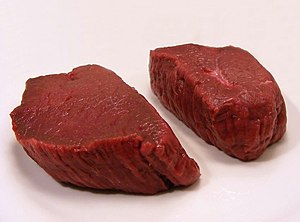Cookbook:Venison
| Venison | |
|---|---|
 | |
| Category | Meat and poultry |
Cookbook | Recipes | Ingredients | Equipment | Techniques | Cookbook Disambiguation Pages | Ingredients | Game
Venison is the meat of the deer and related species. Deer meat is an excellent source of lean animal protein and a healthy alternative to processed foods. As with the meat of other large animals, it is eaten as steaks, roasts, sausages and ground meat. Organ meats are sometimes eaten but would not be called venison. Venison is lower in calories, cholesterol and fat than common cuts of beef, pork or lamb.
Types of venison
[edit | edit source]Deer live in woodlands all over Europe, Asia, northern Africa and America. There are many deer species of various sizes but all the males grow antlers. The meat is lean and has a gamey flavor that can be made milder if soaked overnight.
Elk meat tastes like mild (almost sweet) beef, with only a very faint venison flavor. Elk can be substituted equally for venison in most standard venison recipes. Elk are from North America, Europe, and Asia.
Moose is the largest member of the venison family standing about 6 1/2 feet at the shoulder. It’s native from North America. The meat is similar to elk.
Caribou (reindeer) are slightly larger than white-tailed deer. Both males and females have antlers. The meat is somewhat sweeter than other venison. They live primarily in North America and Siberia.
Antelope are currently farmed in Texas, where black buck and nilgai antelope, native to Africa, are allowed to roam on huge preserves. Males are called bucks, bulls, or stags; females, does or cows; and unweaned young are fawns or calves. Antelope meat is leaner, but similar in taste, to that of deer.
Pronghorn (once classified as "antelope") are native to North America and the only surviving species in the Antilocapridae ("goat-antelope") family. The largest populations are in Wyoming and Montana. Pronghorn meat is leaner, but similar in taste, to that of deer.
Venison as "red" meat
[edit | edit source]All venison is red meat. The coloring comes from myoglobin, a protein in muscle tissue that stores oxygen for later use, and not from blood, which is red due to hemoglobin, the protein that transports oxygen throughout the body.
In extremely fresh meat, the myoglobin is a dark purple color, but it quickly brightens to cherry red when exposed to oxygen in the air, usually within 15 minutes. Over several days, the meat will darken to a brown color as the oxidation of the meat continues.
Cooking guidelines
[edit | edit source]After shooting the animal, the hunter should promptly remove the vital organs from the stomach cavity to preserve the quality of the meat. Remaining carcass can either be self-processed or butchered professionally. The tenderness of a particular cut of venison is similar to the corresponding cut of domestically-raised meat. All game tends to be leaner than that of domesticated animals, which have been bred for tenderness and fat marbling. Overcooking can toughen venison. You can use moist heat, basting, and larding or barding (inserting slivers of fat or wrapping in bacon) to help keep the meat tender during cooking. Fast searing over high heat can also work for smaller cuts, such as tenderloin medallions or rib chops.
